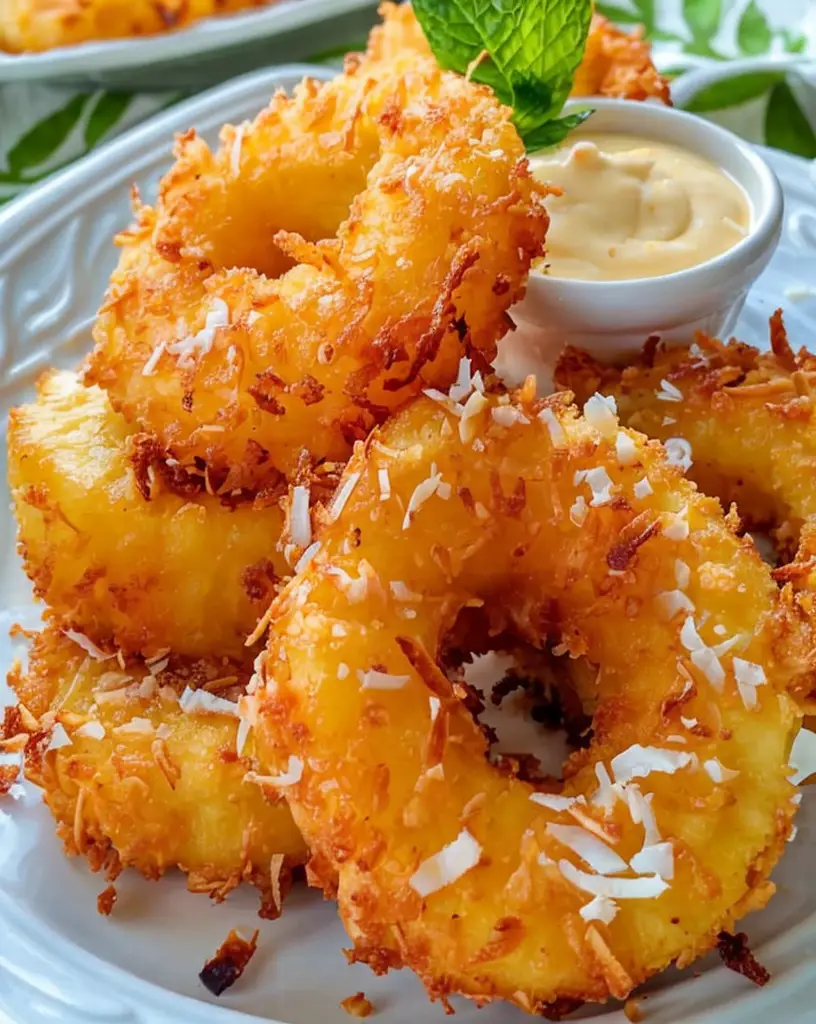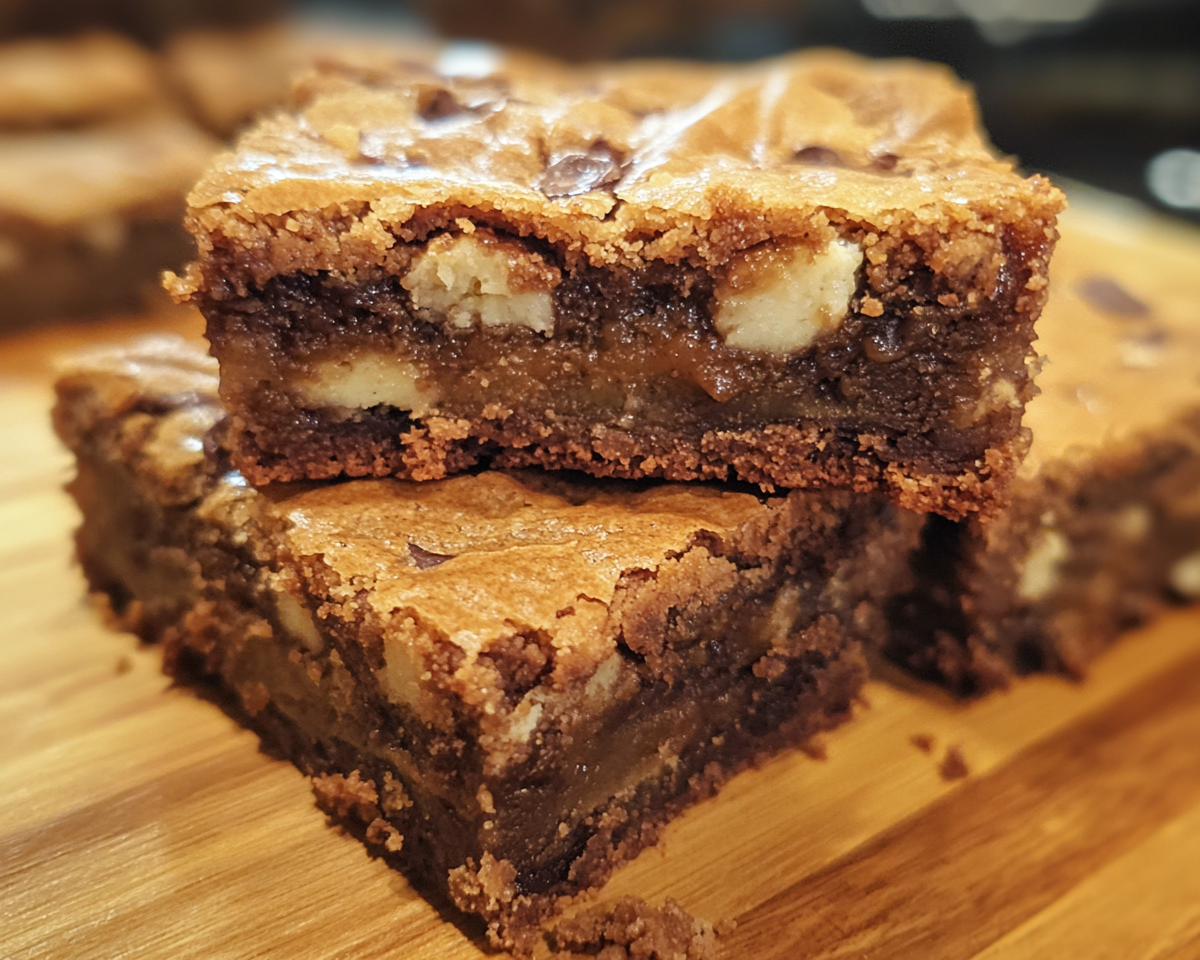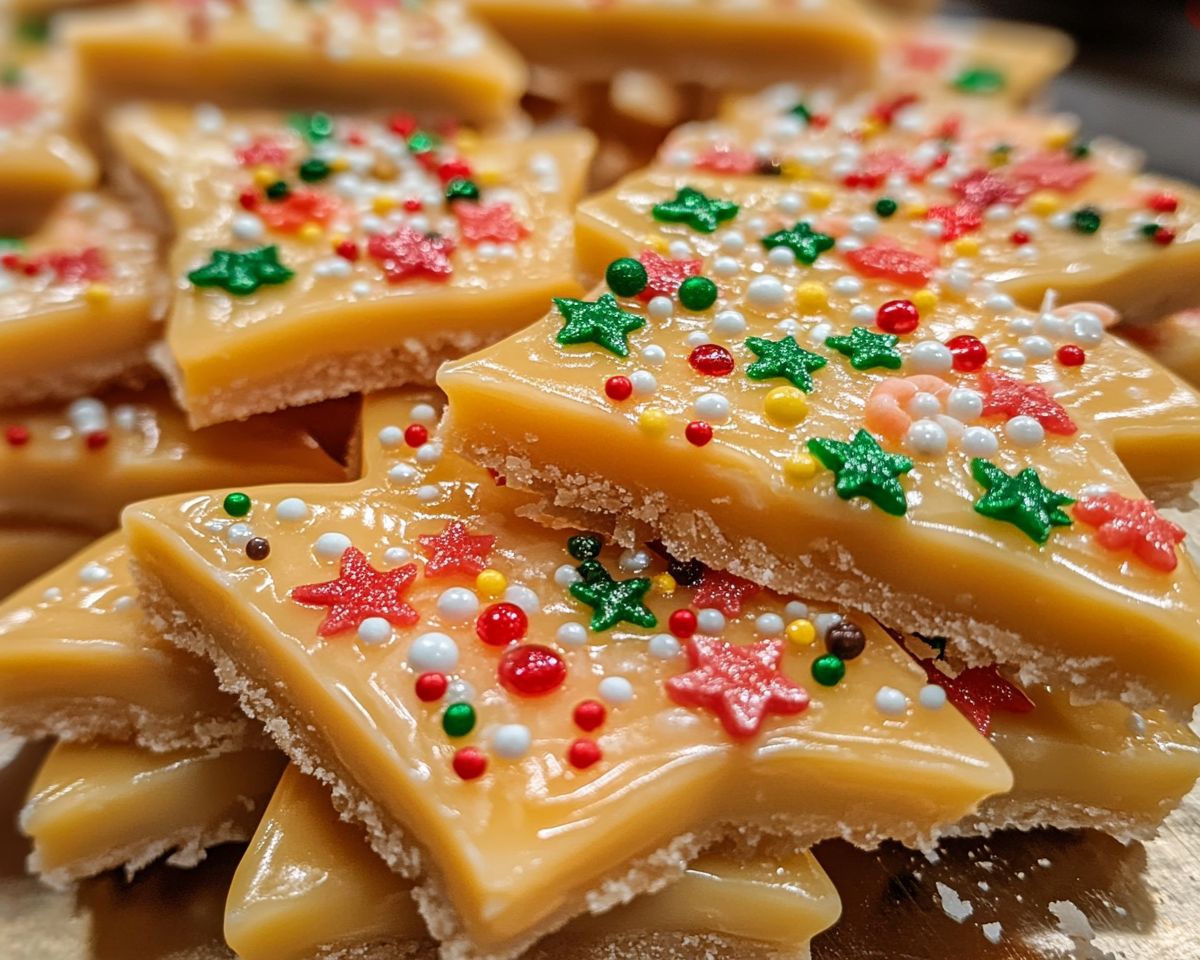Fried Pineapple with Coconut Crust: A Delicious Tropical Treat
Indulge in the mouthwatering experience of Fried Pineapple with Coconut Crust, a delightful dessert that promises to transport your taste buds to a tropical paradise. With its sweet, caramelized pineapple encased in a crispy coconut coating, each bite is a perfect blend of flavors and textures that will make your senses sing. This recipe is not just a delicious treat; it’s a celebration of summer vibes, making it an ideal choice for gatherings, barbecues, or just a cozy night in.
The contrast between the warm, soft pineapple and the crunchy coconut crust offers a unique taste sensation. When paired with a side of vanilla ice cream or a dollop of whipped cream, this dish becomes a symphony of indulgence that encourages you to savor every single bite. Moreover, the bright colors and enticing aroma of the fried pineapple will not only please your palate but also elevate the ambiance of any occasion.
Quick Recipe Highlights
- Flavor Profile: The sweet, juicy pineapple perfectly complements the toasted coconut, delivering a sweet and savory taste with every bite.
- Texture: Delight in the contrast of the crispy coconut outside and the tender, warm pineapple inside, creating a satisfying mouthfeel.
- Aroma: The tantalizing aroma of frying coconut and caramelized pineapple will fill your kitchen, evoking feelings of summer and warmth.
- Visual Appeal: The golden-brown color of the coconut crust contrasted with the vibrant yellow of the pineapple creates an inviting presentation.
- Skill Level Needed: Easy preparation and cooking make this recipe accessible to novice cooks and a fun challenge for experienced chefs.
- Special Equipment: Just a skillet or frying pan is needed, making this recipe straightforward and easy to execute.
Recipe Overview
- Difficulty Level: This recipe is categorized as easy, making it suitable for anyone looking to impress without spending hours in the kitchen. The steps are simple, with the main process involving frying.
- Category: This dessert fits perfectly into the snack or dessert category, ideal for warm-weather gatherings or as a sweet treat after a meal.
- Cuisine: Fried Pineapple with Coconut Crust is inspired by tropical cuisines, showcasing flavors typical of Southeast Asian desserts.
- Cost: The cost of ingredients is relatively low, making this indulgent recipe affordable. Expect to spend around $10–$15 for four servings.
- Season: Best enjoyed during the summer when pineapples are in season, this recipe embraces fresh, juicy fruit with a tropical flair.
- Occasion: Perfect for barbecues, summer parties, or as a refreshing finale to a family dinner, Fried Pineapple is versatile for all occasions.
Why You’ll Love This Recipe
Fried Pineapple with Coconut Crust not only tantalizes your taste buds with its perfect balance of sweetness and crunch, but it also offers a delightful culinary experience that invites sharing and enjoyment. The unique blend of flavors, highlighted by the golden coconut crust, provides a satisfying treat that is both comforting and exotic. It is a dessert that will encourage you to savor every bite, boosting your mood instantly.
Moreover, the convenience of preparing this dessert makes it a winner among busy home cooks. With minimal prep time and a short cooking duration, you can whip up this exquisite dish quickly, leaving you free to enjoy time with family and friends. The ease of preparation ensures that even novice cooks can become dessert pros, presenting this beautiful dish with confidence.
From a nutritional standpoint, this recipe features fresh fruit and coconut, both of which offer benefits. Pineapple is known for its digestive properties and vibrant vitamin C content, while coconut provides healthy fats and adds a satisfying crunch. Together, they create a dessert that, while indulgent, can also fit within a healthier dietary framework when enjoyed in moderation.
For social occasions, this dish serves as an impressive centerpiece. Its striking visual appeal and exotic flavors will be a conversation starter, inviting guests to gather around and share in the experience. Whether served as a standalone dessert or paired with ice cream, the Fried Pineapple with Coconut Crust creates an inviting atmosphere of togetherness.
Lastly, the cost-effectiveness of this recipe simplifies dessert preparation. With budget-friendly ingredients and an accessible cooking method, you can treat your loved ones to a delightful dessert without breaking the bank. This accessibility allows everyone to enjoy a taste of the tropics at home.
Historical Background and Cultural Significance
The origins of fried pineapple can be traced back to various tropical regions where pineapples thrived, notably in Southeast Asia and the Caribbean. In these areas, the fruit is frequently featured in both savory and sweet dishes, showcasing its versatility and popularity. The practice of frying fruit with a crust has deep cultural roots, often used to create treats during festive occasions or as a special family recipe passed down through generations.
Culturally, pineapples symbolize hospitality and warmth, making a dessert like Fried Pineapple with Coconut Crust a delightful addition to social gatherings. This dish’s ability to bring people together is reflective of the communal eating traditions tied closely to many tropical societies, where sharing food fosters togetherness and connection.
As culinary traditions evolved, regional variations of fried pineapple emerged, each adapting the basic concept with local ingredients and flavors. For example, in some cultures, the addition of spices, such as cinnamon or nutmeg, gives the dish a unique twist that celebrates regional taste preferences.
Today, Fried Pineapple with Coconut Crust has gained popularity worldwide, celebrated by food enthusiasts for its delightful taste and unique presentation. The dish brings together the essence of tropical flavors, making it a favorite for those seeking an exotic yet accessible dessert option.
Ingredient Deep Dive
Pineapple
Pineapple holds great cultural significance, particularly in tropical regions where it is often seen as a symbol of hospitality and warmth. This fruit is bursting with nutrients, particularly vitamin C, and contains bromelain, an enzyme known for its digestive health benefits.
When selecting pineapples, look for one that is firm yet slightly soft when pressed, indicating ripeness. Store whole pineapples at room temperature for up to two days and refrigerate cut pieces to maintain freshness. For recipe adaptability, canned pineapple can be used, though be cautious of added sugars.
Coconut
Coconut is revered in many cultures, particularly in Southeast Asia, where it plays a significant role in cuisine and traditional practices. Beyond its delicious flavor, coconut offers health benefits, including healthy fats that can aid in heart health.
Choose unsweetened shredded coconut for this recipe, ensuring the best flavor and texture. It should be kept in a cool, dry place, and can be stored in the refrigerator for extended freshness. If needed, substitute with almond flour for a nutty twist, but ensure to adjust cooking times slightly.
Common Mistakes to Avoid
- Not allowing the oil to heat properly before frying. This can lead to soggy coconut crust and improperly cooked pineapple.
- Using ripe but not overripe pineapples, as overly ripe pineapples can be too soft and lose shape while cooking.
- Overcrowding the skillet can cause uneven cooking. Fry the pineapple in small batches for better results.
- Skipping the coating step. Ensure each piece of pineapple is adequately covered with coconut for an even crust.
- Not monitoring the cooking time closely can result in burnt coconut or overly caramelized pineapple.
- Failing to flip the pineapple at the right moment can lead to uneven cooking of the starches and sugars.
- Using sweetened coconut instead of unsweetened can overpower the natural flavors of the fried pineapple.
- Not allowing the fried pineapple to drain on paper towels can result in an oily texture that detracts from the dish.
- Skipping the cooling period before serving can lead to melting ice cream if served together.
- Neglecting to taste while preparing to determine if more seasoning is needed.
Essential Techniques
Frying is the key technique for this recipe, and it’s particularly important to master it to achieve the desired crunch and flavor. Proper frying involves preheating oil to the right temperature—this ensures an even cook and allows the coconut to crisp without soaking in excess oil.
Don’t rush the frying process. Each side should be cooked until golden brown, usually about 3-4 minutes per side. The color of the coconut crust is a visual cue that signifies readiness; a golden-brown crust indicates perfect frying.
Pro Tips for Perfect Fried Pineapple with Coconut Crust
To ensure your Fried Pineapple with Coconut Crust turns out exceptional, consider these tips:
1. Choose fresh, ripe pineapples for the best flavor. Look for pineapples that have a pleasant aroma and firm texture.
2. Toast the shredded coconut lightly in the oven before using, enhancing its flavor and crispness.
3. Experiment with dipping sauces, like chocolate or caramel, to elevate the serving experience.
4. Use a thermometer to check oil temperature; the ideal frying temperature is around 350°F to 375°F.
5. Allow the fried pineapple to rest on paper towels to absorb excess oil before serving.
6. For added flavor, mix a pinch of salt or cinnamon into the coconut coating.
7. Pair this dessert with a fresh fruit salsa for an added layer of taste.
8. Chill your plate or serving dish before plating to maintain the dish’s temperature.
Variations and Adaptations
Explore different regional variations by incorporating local spices, such as cardamom or chili powder, into the coconut batter. This adjustment can provide an exciting twist to the original flavor profile.
Seasonal adaptations could include using mango or banana instead of pineapple, giving it a unique seasonal flair while still keeping the same delicious coconut coating. For healthier options, consider baking the coconut-crusted fruit in the oven rather than frying, reducing oil consumption.
Those on specific dietary plans can easily modify this recipe. To create a gluten-free dessert, ensure the coating ingredients are free from gluten. For a vegan version, swap out any milk-based dips with coconut milk or a dairy-free alternative.
Texture modifications can also be made by crushing the coconut into finer crumbs, creating a different mouthfeel or even adding nuts for an additional crunch. Presentation can also vary by serving the fried fruit in parfaits with layered yogurt and granola.
Serving and Presentation Guide
To plate your Fried Pineapple with Coconut Crust beautifully, start by arranging the pineapple pieces in a circular pattern on a clean white plate, providing contrast to the vibrant colors of the dish. Drizzle with honey or a sauce of your choice to enhance visual appeal.
Consider garnishing the dish with fresh mint leaves or toasted coconut flakes for an elegant finish. Serve with a side of vanilla ice cream or whipped cream, allowing guests to customize their dessert experience.
Temperature is crucial; serve the dish warm for the best flavor and texture. For portion control, slice larger pieces of pineapple into smaller bites, making it easier for guests to enjoy during casual gatherings.
Wine and Beverage Pairing
Enhance your dining experience by pairing Fried Pineapple with Coconut Crust with a chilled glass of Moscato or a fruity Sauvignon Blanc. Both wines bring out the tropical flavors of the dish, balancing sweetness with acidity.
For non-alcoholic options, consider serving with coconut water or a refreshing fruit spritzer. These beverages will complement the tropical theme of the dish without overwhelming the palate.
A cup of herbal tea, such as chamomile or peppermint, can also serve as a soothing balance to the sweetness of the dessert. Ensure the drinks maintain a cool temperature to balance the warmth of the fried pineapple.
Storage and Shelf Life
To store leftover Fried Pineapple with Coconut Crust, place it in an airtight container and refrigerate for up to 3 days. For optimal texture, it’s better to consume it fresh.
While reheating, avoid using the microwave, as this can make the coconut crust soggy. Instead, use an oven at a low temperature to restore crispness.
For longer storage, consider freezing the fried pineapple. Lay the pieces on a baking sheet to freeze individually before transferring to a freezer-safe container. Ensure consumption within a month for best quality. Upon thawing, a quick re-fry in a hot skillet can revitalize the texture.
Make Ahead Strategies
For those looking to prepare in advance, the pineapple can be sliced and coated in coconut the day before serving. Store the prepared pieces in the refrigerator to maintain freshness.
If frying the day before an event, ensure to allow the fried pineapple to cool completely before storing, as residual heat can cause condensation and sogginess. Reheat just before serving for the best taste experience.
Quality can be impacted if the fried pineapple is made too far in advance, so aim to complete frying within two hours of serving. Consider adding fresh elements, like a fruit salsa or dipping sauce, just before serving for a refreshing touch.
Scaling Instructions
Scaling this recipe is simple and effective. To halve the recipe, adjust the ingredient amounts accordingly, ensuring even distribution of coconut and pineapple.
If doubling or tripling, consider the size of your skillet, as overcrowding can lead to uneven frying. You may need to work in batches for best results.
Timing modifications may be necessary when scaling up the recipe. Keep a close eye on cooking times, as larger quantities may require a few extra minutes for the perfect golden crust.
Also, when storing larger batches, use multiple containers to preserve freshness and quality.
Nutritional Deep Dive
This Fried Pineapple with Coconut Crust serves as a delightful indulgence with proper moderation. A typical serving can deliver about 200 calories, primarily from natural sugars in the pineapple and healthy fats in the coconut.
In terms of micronutrients, pineapple is rich in vitamin C and manganese, while coconut is a good source of dietary fiber and healthy saturated fats. Balancing this dessert with protein or healthy fats can create a more complete meal.
Dietary considerations should always be taken into account. For those managing weight, enjoying a smaller portion or serving it with fresh fruit can reduce overall caloric intake while still enjoying the flavors.
Dietary Adaptations
For families dealing with specific dietary needs, this recipe offers several adaptations. To make it gluten-free, ensure all coating ingredients are certified gluten-free, and use corn starch instead of flour if a binder is needed.
For a dairy-free version, pair the fried pineapple with coconut yogurt or a homemade cashew cream, amplifying that tropical flair. Those on a keto or low-carb diet could consider substituting the sweetener or reducing the sugar in the coating for fewer carbs.
Vegan diners can enjoy this dessert by ensuring the dipping sauce or side accompaniments are plant-based, while paleo enthusiasts can use natural sweeteners like honey or maple syrup to adhere to their dietary patterns.
Troubleshooting Guide
For texture issues, if the coconut crust is not crispy, the oil temperature may be too low. Ensure a steady temperature for optimal frying.
If the flavor balance feels off, consider adjusting the sweetness or acidity by adding a light squeeze of lime or sprinkling salt to enhance all flavors.
If you encounter temperature problems while frying, remember to monitor the heat closely; too high can burn the coconut, while too low can cause sogginess.
Should you face equipment challenges, like frying in a non-stick pan that isn’t working, switch to cast iron for better heat retention and even cooking.
Timing concerns can be resolved by preparing the components in advance, allowing you to fry only when ready to serve, ensuring the best texture and flavor.
Recipe Success Stories
Community feedback often highlights the joy brought by this recipe. Many readers share their experiences of serving Fried Pineapple with Coconut Crust at summer gatherings, impressing guests with its flavor.
Success with variations is a common theme, with users adapting the basic concept to include different tropical fruits, showcasing the versatility of the recipe. From mango to peaches, the adaptability allows for creativity while maintaining a delicious standard.
Photography tips shared by readers emphasize the vibrant colors and contrasting textures prevalent in the dish. Using natural lighting and simple plating techniques can help highlight the golden crust and juicy interior.
Variations suggested by the community feature unique sauces and accompaniments that enhance the overall dish while maintaining the essence of the Fried Pineapple.
Frequently Asked Questions
Can I use canned pineapple for this recipe?
Yes, you can use canned pineapple, but opt for the unsweetened variety for the best flavor. Drain and pat dry the pieces thoroughly before coating with coconut to avoid excess moisture.
Is it necessary to let the coconut toast before using?
Toasting the coconut enhances its flavor and can help achieve a crunchier texture. It’s not essential, but for optimal taste, it’s recommended.
What can I serve with Fried Pineapple?
This dish pairs well with vanilla ice cream, whipped cream, or a light fruit salsa. Adding a dip enhances the context of the dish while providing extra flavor.
Can I make this recipe gluten-free?
Absolutely! Ensure that all ingredients used, including the shredded coconut, are certified gluten-free to safely adapt this recipe for gluten-intolerant individuals.
How do I store leftovers?
Store leftovers in an airtight container in the refrigerator for up to 3 days. For better preservation, consider freezing, although the texture may not be as crisp upon reheating.
Can I bake instead of frying?
Yes, you can bake the coconut-crusted pineapple for a healthier option. Preheat the oven to 375°F and bake for about 15 minutes, flipping halfway through until golden brown.
How do I know when the pineapple is done frying?
The pineapple is typically ready when the coconut is golden brown and crispy. A visual cue in prickling color change is a good indicator of doneness.
Is this recipe suitable for a vegan diet?
Yes, simply ensure that any dipping sauces or additional toppings are made with plant-based ingredients to keep the dish vegan-friendly.
Can I substitute the pineapple with other fruits?
Yes! Other fruits such as mango, banana, or pear can be substituted to create unique flavor profiles while maintaining the same crispy coconut crust.
What type of coconut should I use?
For this recipe, it’s best to use unsweetened shredded coconut. Sweetened coconut can alter the flavor profile and is not recommended.
Additional Resources
Expanding on tropical desserts, check out our recipe for Coconut Macaroons or try a refreshing Mango Sorbet that complements the flavors found in this dish.
For guidance on perfect frying techniques, explore our technique guides, showcasing stovetop frying tips, and alternative cooking methods like air frying.
Incorporating our ingredient information on pineapples and coconuts can enrich your understanding of these key components, enhancing your culinary insights.
Lastly, consider exploring seasonal variations, bringing forth citrus flavors during winter months or berry adaptations in late summer, keeping your dessert experiences exciting year-round.
Join the Conversation
We invite you to connect with us by sharing your experiences and adaptations of the Fried Pineapple with Coconut Crust recipe. Post your photography and feedback on social media, tagging us for a chance to be featured.
Engage with fellow culinary enthusiasts in the comments section, discussing variations and providing tips for success. Recipe reviews and suggestions are welcome, fostering community collaboration in crafting this delightful dish.
Explore different flavor combinations and creative plating ideas that you’ve crafted, as we celebrate everyone’s unique approach to this tropical classic. Let’s create a conversation filled with culinary creativity together!
The Recipe
Fried Pineapple with Coconut Crust
Serves: 4
Prep Time: 15 mins
Cook Time: 10 mins
Total Time: 25 mins
Kitchen Equipment Needed
- Skillet or frying pan
- Tongs or a fork
- Paper towels
- Airtight container for storage
Ingredients
- 1 ripe pineapple, peeled and sliced
- 1 cup unsweetened shredded coconut
- ½ cup all-purpose flour (or gluten-free substitute)
- 2 eggs, beaten
- ½ teaspoon vanilla extract
- Oil for frying (coconut oil recommended)
- Honey or maple syrup for drizzling (optional)
Directions
- Heat the oil in a skillet over medium-high heat.
- In a shallow bowl, combine shredded coconut and flour. In another bowl, beat the eggs and add vanilla extract.
- Dip each pineapple slice in the egg mixture, then coat with the coconut mixture, pressing lightly to adhere.
- Fry the coated pineapple slices in hot oil for about 3-4 minutes on each side, until golden brown.
- Transfer the fried pineapple onto paper towels to drain excess oil.
- Serve warm, drizzled with honey or syrup if desired.
Recipe Notes
- For added crunch, toast the coconut before coating the pineapple.
- Feel free to experiment with spices in the coconut coating for different flavor profiles.
- Consider pairing the fried pineapple with ice cream or a fresh fruit salsa.




